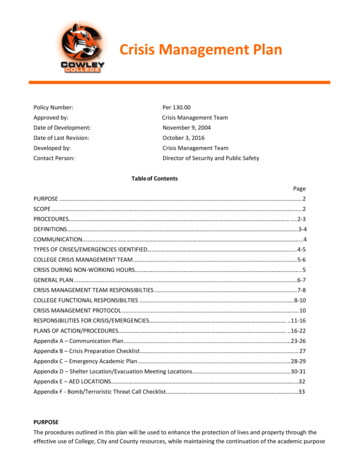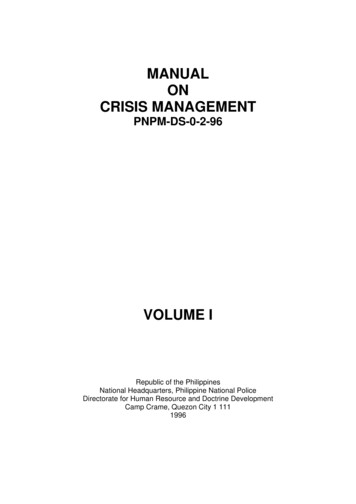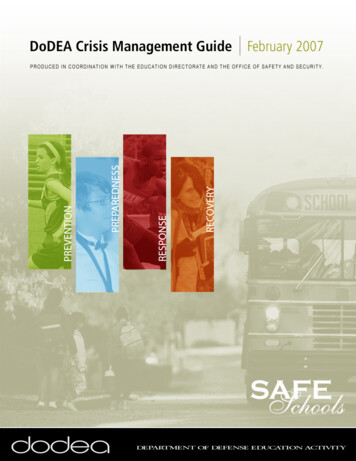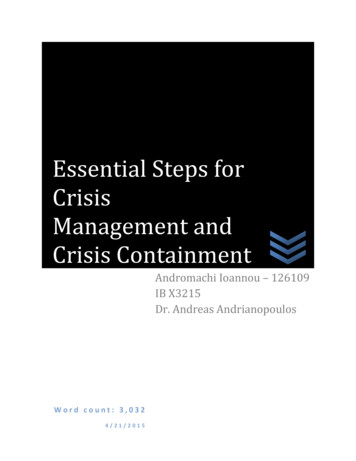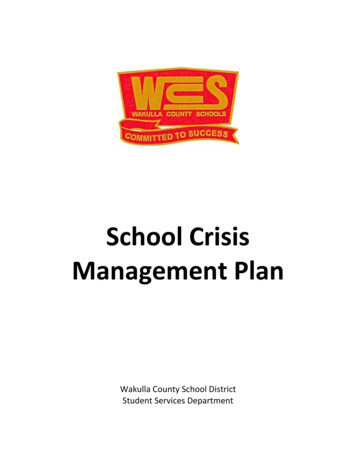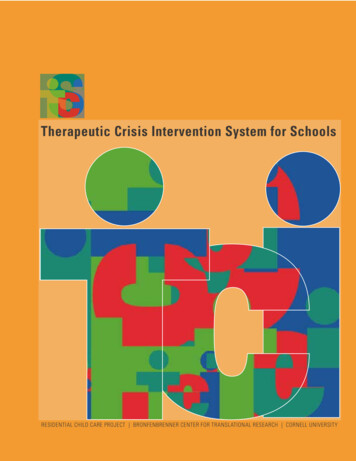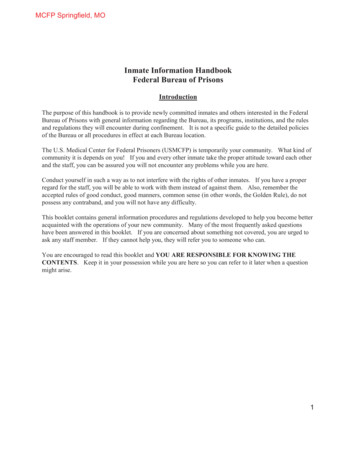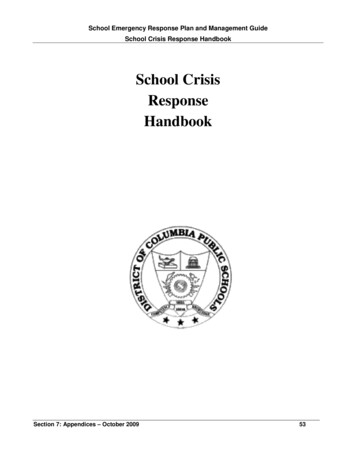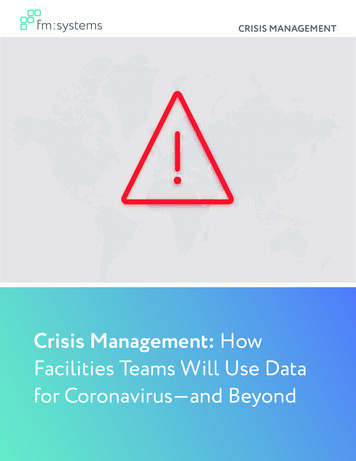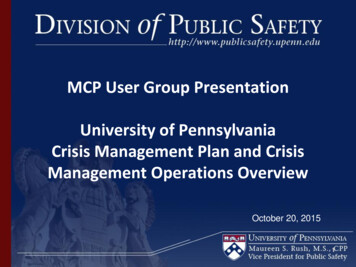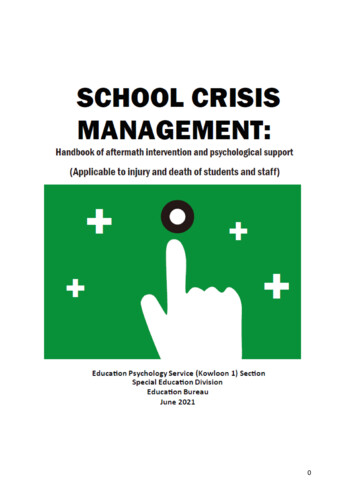
Transcription
0
Contents4PrefaceChapter One: IntroductionDefinition of a Crisis6Assessing the Impact of Crisis Incident on Students and Staff6Basic Principles of Crisis Management and Psychological Support6Chapter Two: The School Crisis Management TeamObjectives and Functions of the School Crisis Management Team8Composition of the School Crisis Management Team9Members of the School Crisis Management Team10Roles and Duties of the Members of the School Crisis Management Team10Preparatory Work for School Crisis Management14Chapter Three: School Crisis Management and Psychological SupportCoordination and Division of Work in School Crisis Management15An Overview of Crisis Management and Psychological Support: Tasks and Persons Responsible15The Flow Chart of Crisis Management and Support171.Verifying information182.Notifying the School Supervisor and the Regional Education Office of Education Bureau183.Conducting School Crisis Management Team Meeting184.Liaising with Outside Agencies for Support225.Support to Staff236.Support to Students277.Support to Parents418.Participating in Memorial Activities and Funeral449.Handling the Media4410.Evaluation of Crisis Management4650References1
Annexes55Templates and FormsPreparatory Work for School Crisis Management57Annex 1: Directory of Support and Services58Annex 2: Designated Use of RoomsSchool Crisis Management Team Meeting59Annex 3: Agenda for School Crisis Management Team Meeting60Annex 4: Initial Impact Assessment for Students and StaffSupport to Staff63Annex 5: Agenda for Staff Meeting64Annex 6: Reminders for Teachers65Annex 7: Content of Emotional Support Group for StaffSupport to Students68Annex 8: Announcement to Students (Sample 1)69Annex 9: Announcement to Students (Sample 2)70Annex 10: Content of Brief Class Meeting71Annex 11: Content of Special Class Period73Annex 12: Brief Class Meeting/Special Class Period: Teachers’ Feedback Form74Annex 13: Content of Group Counselling for Students77Annex 14: Content of Individual Counselling for StudentsSupport to Parents78Annex 15: Special Notice to Parents (Sample 1)79Annex 16: Special Notice to Parents (Sample 2)80Annex 17: Content of Parent MeetingHandling the Media81Annex 18: Press Release SampleEvaluation of Crisis Management82Annex 19: Agenda for Crisis Management Evaluation Meeting83Annex 20: Crisis Management and Support Measures Evaluation Questionnaire2
Reference MaterialsReference 1A: Common Initial Post-crisis Reactions (Children)85Reference 1B: Common Initial Post-crisis Reactions (Adolescents)87Reference 1C: Common Initial Post-crisis Reactions (Adults)89Reference 1D: Continuous and/or Serious Reactions Triggered by Crisis Incident91Reference 2: How Should Teachers Respond to Students’ Possible Reactions92Reference 3: Coping Strategies97Reference 4: Relaxation Exercise98Reference 5: How Can Parents Help their Children Cope with Crisis Incident100Reference 6: Frequently Asked Questions on How Can Parents Help their Children Handle Emotions1023
PrefaceCrisis management is a challenging task.should always be well prepared.In order to stay calm in critical situations, weThe Education Bureau (EDB, the then Education andManpower Bureau) issued the Ebook on School Crisis Management in April 2005, whichprovided the education sector and relevant professionals references on crisis management andsupport. Based on the experiences that the EDB and relevant professionals accumulated overthe years in assisting schools in managing crises, as well as the continuous development in theresearch and studies relating to school crisis management, we have enriched the Ebook onSchool Crisis Management and published this School Crisis Management: Handbook ofaftermath intervention and psychological support.It aims at facilitating schools to match theneeds of students, staff, parents and schools with appropriate crisis management andpsychological support, with a view to helping these individuals overcome crises and theschools resume normal routine.For immediate handling of accidents or emergency situations,please refer to the related parts of the School Administration Guide.For management ofstudents’ suicidal behaviours, please refer to the Resource Handbook for Schools: Detecting,Supporting and Making Referral for Students with Suicidal Behaviours at the following link:EDB Homepage Teachers Related Prevention of Student Suicides and Promotion ofStudent Mental /prevention-of-studentsuicides/Resource Handbook for Schools En.pdfChapter 1 of this handbook introduces the basic principles of school crisis managementand the arrangement of psychological support.Chapter 2 provides an overview of theestablishment, operation and preparatory work of the School Crisis Management Team.Chapter 3 elaborates on the assessment, intervention and support measures which should becarried out following crisis incidents.Relevant forms and templates are included in theAnnexes for schools’ reference and use.Schools are encouraged to make reference to this handbook and, when necessary, makeappropriate modifications and adjustments according to schools’ needs, and formulate supportplans for various types of crisis.Before the occurrence of crisis incidents, schools shouldfamiliarise themselves with the crisis management and support procedures, as well as the actualoperational details that require due attention. Schools are also advised to organise regularstaff training and drills so as to equip staff with the knowledge and skills to help schools get4
through crises.5
Chapter One: IntroductionDefinition of a CrisisIn the wake of a crisis, an individual’s resilience is compromised in a way that the usualcoping strategies are inadequate to deal with the threat.Events that might precipitate a crisis in schools include suicide or self-harm behaviours,sudden or accidental death and critical injury of a student or staff, as well as violent incidentsand natural disasters. These incidents may bring chaos to a school and threaten its stability,making students and staff feel threatened, upset, insecure, helpless, etc. Besides, rumoursoften spread after crisis incidents while subjective and arbitrary remarks may furthertraumatise students and staff. In the meantime, the school concerned often has to provideinformation to different stakeholders. All of the above situations may induce great pressureon the school administration system. Schools should implement contingency measures tominimise the negative impacts of the incident.Assessing the Impact of the Crisis Incident on Students and StaffIt is the interaction effects of various factors rather than a single factor that determine theimpact of the crisis incident on people. The factors can be grouped into two categories (a)the characteristics of the crisis incident and (b) the personal risk factors. We also need tounderstand the responses of students and staff to assess the impact of the crisis on them.The characteristics of a crisis incident can include the predictability, duration, intensityand consequences of the crisis incident. Generally speaking, crisis incidents that happenunexpectedly, persist for a long time and cause deaths/serious injuries may be perceived asthreatening to most people. The estimated degree of impact is also affected by personal riskfactors which include physical proximity, emotional proximity and personal vulnerabilities.Generally speaking, individuals who have witnessed the crisis or stayed at the scene,individuals who have a closer relationship with the victim, individuals with mental healthproblems, or individuals with less social support and weak coping skills could be more affectedby the incident (Brock, 2011). Schools can assess the psychological and emotional impactof the incident on students and staff with reference to Annex 4 and determine the appropriatesupport measures for them. For details of support plans and measures, schools can refer toChapter 3 of this handbook.Basic Principles of Crisis Management and Psychological SupportWhen facing a crisis, it is common for students and staff to have various emotional,cognitive, physiological, social and behavioural reactions e.g. feeling upset, difficulty in6
concentration, feeling fatigued, having poor appetite, etc (See Reference 1A, 1B, 1C). In mostsituations, these reactions subside after a few days or weeks as a process of natural recovery.In the initial stage after the crisis, basic support includes assisting the affected students andstaff to clarify facts of the crisis incident and cope with the crisis impact. Teachers or schoolcounsellors should provide appropriate psychoeducation, for example teaching copingstrategies, and strengthen their social support system, for example the support from families,teachers and friends.However, some students and staff may be more severely affected, such as experiencingpersistent difficulty in falling asleep, frequent nightmares, or repeated flashbacks of theincident to the extent that their daily life is affected (See Reference 1D).need to keep observing and assessing the needs of students and staff.Therefore, schoolsGroup or individualcounselling may also be provided as deemed necessary to help them relieve their distress andresume normal life.There are multiple factors determining the crisis impact on students and staff, includingthe characteristics of the crisis incident, relationship with the victim, individual’s copingskills, etc. Facing the same crisis incident, different people will be affected to a varyingdegree. Inappropriate intervention or providing the same mode/ level of support forindividuals with different degrees of impact may affect their natural recovery process. On theother hand, the lack of timely/ appropriate support to those in need may delay their recoveryprocess. Therefore, it is important to assess the crisis impact on different students and staff toidentify individuals in need and provide them with appropriate support.In addition, the crisis impact on students and staff may change over time.Schools needto keep observing and assessing the needs of individuals at different periods (e.g. a fewhours, a few days and a few weeks after the crisis incident) and arrange appropriate supportaccordingly.Overall, schools should have adequate preparation to accurately assess the impact of theincident on students and staff, so that timely and appropriate intervention and support can berendered in time of a crisis.7
Chapter Two: The School Crisis Management TeamObjectives and Functions of the School Crisis Management TeamAccording to the “School Administration Guide”, schools have to set up the School CrisisManagement Team (SCMT) to establish mechanisms for effective handling of crises andformulate relevant procedures and contingency plans for any potential crises and emergencysituations. When a crisis incident takes place, the SCMT is also responsible for coordinatingand deploying both internal and external resources, to arrange timely and appropriatepsychological support, with a view to minimise the impact of the incident on the school andits students and staff. This chapter provides an overview of the objectives and functions ofthe SCMT:Objectives of the School Crisis Management Team Safety: to ensure the safety of all students and staff. Stability: to re-establish stability of the school routines as soon as possible. Information Dissemination: to ensure the consistency of information in andoutside school and to eliminate the spread of rumours, so as to avoid causingunnecessary distress to students and staff. Identification: to identify at-risk students and staff for referral to appropriatecounselling and follow-up services. Emotional Support: to provide emotional support to students and staff in distressand help them readjust to their lives. Empowerment: to enhance the personal growth of students and staff througheffective coping with the incident.Functions of the School Crisis Management Team Formulate a crisis management support plan; Assess the impact of the crisis incident on the school; Collect and disseminate updated information of the crisis incident and makeclarification when necessary; Coordinate internal and external resources, and provide timely and appropriateintervention and support; Provide support to teachers, students and parents;8
Monitor the progress of crisis management; Evaluate the crisis management support plan; Coordinate all the follow-up work.Composition of the School Crisis Management TeamThe school principal should play a leading and monitoring role in crisis management.He/she has to assign tasks appropriately, have a good grasp of the progress of intervention andhandle external enquiries.As the school principal may have to make multiple importantdecisions within a short period, he/she should reserve adequate time for oneself.Werecommend that the team leader of the SCMT to be someone at the school management level,e.g. the vice-principal, or a senior teacher who is familiar with the overall operations of theschool.The team leader needs to lead the SCMT and keep close contact with the schoolprincipal for making relevant important decisions. Schools should select suitable teachers towork with the team leader. They will be responsible for supporting the staff, communicatingwith parents, and liaising with supporting agencies etc.School social workers andeducational psychologists are required to be members of the team, providing professionaladvices, support and follow-up services according to the nature of crisis. Schools shouldnominate at least one or two staff to join the team as back-up support, so as to enhance theteam’s operational flexibility and capabilities in handling crises.Composition of the SCMT:School PrincipalTeam CommunityLiaisonIn-chargeSchool tOtherMembers9
Members of the School Crisis Management TeamSchools could consider the following factors for selecting appropriate staff to be members ofthe SCMT: Does he/she gain the trust of the students and staff? Does he/she have the ability to analyse problems and make rational decisions inurgent situations? Is he/she equipped with the relevant knowledge and skills related to crisismanagement? Is he/she sensitive to the feelings and needs of others?Roles and Duties of the Members of the School Crisis Management TeamTeam LeaderRoles: Lead the team members to formulate a crisis management support plan; Make important decisions relating to the crisis management; Oversee and coordinate actions relating to the crisis management.Duties: Verify information from relevant parties (e.g. the number of casualties, the severity ofinjuries or condition of students); Maintain close contact with the school principal and consult his/her advice; Seek support from the EDB and/or relevant government departments/other organisations; Gather the members of the SCMT and activate the crisis management procedures; Consult the staff liaison in-charge about the support to staff; Consult the parents liaison in-charge about the support to parents; Coordinate responses to the media, assign a spokesperson to disseminate information toand answer enquires from the public; Conduct an evaluation meeting of the crisis management and support plan after the crisisis settled.Staff Liaison In-chargeRoles:Coordinate the support to staff10
Duties: Establish a phone contact group so that information can be disseminated as soon aspossible after a crisis has occurred (e.g. basic information on the crisis incident,arrangements for emergency meetings, etc.); Arrange and assist the school principal in conducting the Staff Meeting; Keep staff informed of the latest situation of the crisis incident; Coordinate the implementation of Brief Class Meeting(s) or Special Class Period(s),including: arrange manpower to support class teachers who need assistance; prepare and distribute materials for use in Brief Class Meeting(s) or Special ClassPeriod(s); oversee the implementation of Brief Class Meeting(s) and/or Special Class Period(s)and provide immediate assistance when necessary.Parents Liaison In-chargeRoles: Coordinate the support to the victim’s family; Coordinate communication with other parents.Duties: Contact and offer support to the victim’s family; Contact parents of students affected by the incident; Prepare and distribute the Letter to Parents; Arrange a spokesperson to answer parents’ enquiries and conduct Parent Meetings ifnecessary.Community Liaison In-chargeRoles: Coordinate external resources to provide support to the school, staff and students.Duties: Maintain an updated list of community resources, including a directory of support andservices (Annex 1); Familiarise himself/herself with the referral procedures and services offered by differentagencies in the community;11
Discuss with team members to see if external support is needed; Make/assist in making referrals for students, staff or parents in need of external supportservices; Keep contact with the related agencies after referrals, so that assistance and follow-upsupport can be provided at school.School Social Worker/Guidance TeacherRoles: Support the school in crisis management, especially in rendering counselling/guidance tostudents, staff and parents.Duties: Work together with external support personnel to arrange or provide counselling tostudents and staff in need, and make referrals for appropriate follow-ups when necessary; Assist teachers in conducting Brief Class Meeting(s) or Special Class Period(s); Provide emotional support to staff; Provide emotional support to parents; Arrange practical support to the victim’s family, e.g. applying for financial subsidy.Educational PsychologistRoles: Provide professional advice and support on school crisis managementDuties: Provide professional advice and support to the school on the impact assessment of thecrisis, formulation of the support plan and communication with external parties; Support teachers in conducting Brief Class Meeting(s) or Special Class Period(s); Provide individual or group counselling to students and assist the school in arrangingappropriate follow-up services; Provide emotional support to staff.12
Other Team MembersRoles: Share the duties in rendering support related to crisis managementDuties: Designate rooms for different uses and inform the staff concerned of the arrangement(Annex 2); Assist class teachers in conducting Brief Class Meeting(s) or Special Class Period(s); Assist in preparing and distributing materials for use in Brief Class Meeting(s) or SpecialClass Period(s); Familiarise themselves with all procedures and the locations of relevant materials/forms,and provide the materials to other members promptly when necessary; Provide secretarial support, e.g. taking minutes, collecting and compiling relevantinformation, and drafting relevant letters and notices; Assist other team members with their duties when necessary.13
Preparatory Work for School Crisis ManagementApart from setting up a SCMT, schools should provide training for all staff members toacquire and consolidate knowledge and skills in crisis management.update relevant reference materials regularly for use by the staff.The SCMT should alsoSchools can make referenceto the templates and forms in the Annexes of this handbook:Preparatory Work for School Crisis ManagementAnnex 1: Directory of Support and ServicesAnnex 2: Designated Use of RoomsSchool Crisis Management Team MeetingAnnex 3: Agenda for School Crisis Management Team MeetingAnnex 4: Initial Impact Assessment for Students and StaffSupport to StaffAnnex 5: Agenda for Staff MeetingAnnex 6: Reminders for TeachersAnnex 7: Content of Emotional Support Group for StaffSupport to StudentsAnnex 8: Announcement to Students (Sample 1)Annex 9: Announcement to Students (Sample 2)Annex 10: Content of Brief Class MeetingAnnex 11: Content of Special Class PeriodAnnex 12: Brief Class Meeting/Special Class Period: Teachers’ Feedback FormAnnex 13: Content of Group Counselling for StudentsAnnex 14: Content of Individual Counselling for StudentsSupport to ParentsAnnex 15: Special Notice to Parents (Sample 1)Annex 16: Special Notice to Parents (Sample 2)Annex 17: Content of Parent MeetingHandling the MediaAnnex 18: Press Release SampleEvaluation of Crisis ManagementAnnex 19: Agenda for Crisis Management Evaluation MeetingAnnex 20: Crisis Management and Support Measures Evaluation Questionnaire14
Chapter Three: School Crisis Management and Psychological SupportCoordination and Division of Work in School Crisis ManagementIt is essential for schools to coordinate the required crisis management measuressystematically, coordinate staff effectively and deploy manpower when necessary for assistingstudents and staff to tide over crises.Schools should specify the roles and responsibilities ofeach member of the SCMT in accordance with the manpower allocation and the expertise ofthe team members, and pay attention to the coordination between each member for effectivecrisis management and support.Schools may refer to “An Overview of Crisis Managementand Psychological Support: Tasks and Persons Responsible” set out below for the allocationof tasks among the SCMT members.An Overview of Crisis Management and Psychological Support:Tasks and Persons ResponsibleTasksPersons ResponsibleOther AssistingMembersTeacher(s) whom thevictim(s) is/are close to1.Verify informationSCMT leader2.Notify the School Supervisorand the Regional EducationOffice of EDBSchool principal3.Conduct SCMT meetingSCMT leaderSchool principal, SCMTmembers4.Liaise with outside agenciesfor supportCommunity liaison incharge,school social worker,guidance teachersStaff concerned5.Support to staffSCMT members2. Conduct EmotionalSupport Group for StaffStaff liaison in-charge,school principalGuidance Master,staff liaison in-chargeSupport to students1. Make announcement tostudents2. Conduct Brief ClassMeetingSchool principal,class teachersClass teachers,staff liaison in-charge3. Conduct Special ClassPeriodClass teachers,staff liaison in-charge1. Conduct Staff Meeting6.School social worker,educational psychologistSchool social worker,guidance teachers,educational psychologistSchool social worker,guidance teachers,15
educational psychologist4. Provideadditional/enhancedsupport to students andstaff in needSupport to parents1. Inform parentsSchool social workerGuidance teachers,educational psychologistParent liaison in-charge2. Conduct Parent MeetingParent liaison in-charge3. Express sympathy to thefamily of the victimParent liaison in-charge8.Handling the mediaSpokesperson delegatedby the schoolSchool social worker,guidance teachers,class teachersSchool principal,guidance teachers, schoolsocial workerSchool principal,class teacher,school social worker,guidance teachersSCMT Leader9.Evaluation of crisis management7.Conduct an evaluationmeetingSCMT LeaderSchool principal, SCMTmembers16
The Flow Chart of Crisis Management/Intervention and SupportSchools should make necessary adaptations to the steps of crisis management and support,depending on the characteristics, severity and actual circumstances of individual incident.Schools can also download and make necessary adaptations to the templates, forms andreference materials set out in the Annexes of this handbook based on their needs.Verify informationNotify the School Supervisor and the Regional Education Officeof EDBConduct SCMT meeting(Annex 3)Conduct initial impact assessment of the crisis incident on studentsand staff(Annex 4)Arrange intervention and psychological supportStaff(Annex 5-7) Conduct StaffMeeting ArrangeEmotionalSupport Group ConductevaluationmeetingStudents(Annex 8-14) Announce thenews Conduct BriefClass Meetingor ConductSpecial ClassParents(Annex 15-17) Inform parents Conduct ParentMeeting Expresssympathy to thevictim’s familyMedia(Annex 18) Prepare pressrelease Respond toenquiriesCommunity(Annex 1) Seek supportfrom outsideagenciesPeriod Provideindividual orgroupObserve, evaluate and follow-up continuously(Annex 19-20)17
When a crisis incident takes place, schools should adopt appropriate measuresimmediately to ensure the safety of students and staff. For example, students and staff shouldbe provided with a safe environment, if necessary, they should be removed from the scene oradjustments should be made to the school routine to minimise the opportunities of witnessingthe scene and protect them from harm. Other examples of immediate safety measures includeproviding food or water to meet their basic needs, and arranging medical care according toindividual circumstances.1. Verifying InformationWhen a school is informed of a crisis incident, the school concerned should gather basicinformation of the incident (e.g. persons involved, the time and location of the incident etc.)from reliable sources such as parents of the student concerned, medical or police officers.Schools must verify the information, which will serve as the basis for the crisis’ initial impactassessment and the reference for follow-up actions.2. Notifying the School Supervisor and the Regional Education Office ofEducation BureauThe school principal should notify the School Supervisor or the designated person-incharge of the school sponsoring body, as well as other management staff if necessary, of theincident. The Regional Education Office of EDB should also be notified as soon as possibleso that the EDB can arrange appropriate support, e.g. assisting the school in responding tomedia enquiries.3. Conducting a School Crisis Management Team MeetingAfter collecting the details of the incident, the school should conduct a SCMT meetingas soon as possible (Annex 3). The purpose of the meeting is to inform team members of theincident and clarify the accuracy of information obtained from different sources. The schoolshould also address the emotional reactions of the team members during the meeting andensure that all members are able to carry out different crisis management tasks. The teamshould draw up a crisis management support plan which includes the implementation schedule,procedures, division of labour, etc.18
Annex 3Agenda for School Crisis Management Team Meeting1.2.3.4.Verify and update the details of the crisis incidentConduct an initial impact assessment and identify at-risk students and staff (Annex 4)Assess if external support or community resources are neededDetermine the scale, scope and target groups of support, and arrange the division of labour Handle enquiries from the media (refer to p.44-46) Handle enquiries from the police Handle enquiries from parents and the publicPrepare scripts for information dissemination (Annex 8-9) for the school principal or class teachers to make announcement to students for staff to respond to enquiriesDiscuss the support format for students Decide on the targets of announcement (e.g. informing all students or only theaffected classes) Decide on the format of announcement (e.g. announcement made by class teachersin each class) Arrange Brief Class Meeting or Special Class Period for students according to theassessed needs Arrange counselling services for students who are identified to be more affected bythe incident Arrange venuesDiscuss support formats for staff or parents;Prepare for the Staff Meeting (Annex 5)19
Annex 4Initial Impact Assessment for Students and Staff(A) Basic information of the crisis incidentDate/Time/Location of the incident:Brief Description of the incident:Significant incident(s) preceding theincident:Media coverage of the incident:School’s experience in handling similarincident:(B)Background information of the victim (if applicable):Name of victim:Sex:M / F (Please delete where appropriate)Age:Class:Date of birth:Home address:Family background:School performance:- Academic:- Social relationship:- Extra-curricular activities:Support services received:(C) Identification of at-risk students and staffThe following questions can be used as reference to help identify at-risk students and staff.The impact of a crisis incident is determined by the interaction effects of various factors.Schools should consider the unique nature of each crisis incident when assessing the possiblepsychological and emotional disturbances incurred on students and staff and determining thecorresponding intervention.I.Physical Proximity Who witnessed the incident (e.g. witnessing the moment when the victim fallingfrom height)? Who was/were present at the scene (e.g. witnessing the victim receiving first aidafter the incident)?20
Tips: The closer a person stays at the scene of the incident, the higher the risk ofpsychological trauma is. For instance, if a student saw a person falling from height or thestudent was present at the scene, the incident might have a greater impact on him/her.(List out the at-risk class(es)/ group(s)/ students/ staff)II.Emotional Proximity Who had a close/special relationship with the victim?Who participated in the same activity or organisation as the victim did?Tips: The closer the relationship the person has with the victim, e.g. best friends or familymembers, or having an unsatisfactory relationship with the victim, the higher the risk ofpsychological trauma he/she may have. For instance, if a beloved student died, theincident might have a greater impact on students/staff.(List out the at-risk class(es)/ group(s)/ students/ staff)III. Personal Vulnerabilities Who experienced/ have been affected by a similar critical incident in recent years? Who experienced the loss of a significant person or other traumatic incidents inrecent years? Who used to adopt a more positive (vs. negative) attitude to cope with critical incidents?Who could regulate their emotions more properly (vs. easily lose their emotionalcontrol)?Who could obtain more ad
School Crisis Management and published this School Crisis Management: Handbook of aftermath intervention and psychological support. It aims at facilitating schools to match the needs of students, staff, parents and school
